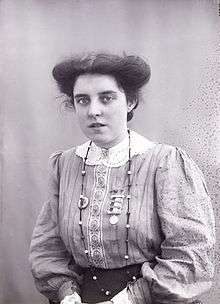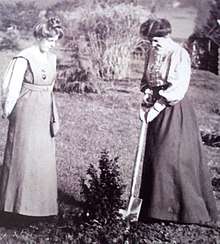Theresa Garnett
| Theresa Garnett | |
|---|---|
 Garnett in 1909 | |
| Born |
17 May 1888 Leeds, England |
| Died |
24 May 1966 (aged 78) Whittington Hospital |
| Nationality | United Kingdom |
| Known for | Militancy and assaulting Winston Churchill |
Theresa Garnett (17 May 1888, Leeds – 24 May 1966, London) was a British suffragette. She was a serial protester who was jailed and then still refused to cooperate. She audaciously assaulted Winston Churchill while carrying a whip. She retired from her militancy after the suffragette movement decided to commit arson as part of its protests. She was honorary editor of a women's right's magazine in 1960.
Biography
Theresa Garnett was born in Leeds in 1888,[1] daughter to Joshua Garnett and Frances Theresa Garnett[2] and was educated at a convent school.[3]
She worked for some time as a teacher. In 1907, she joined the Women's Social and Political Union (WSPU) after being inspired by a speech given by Adela Pankhurst.[4] In April 1909, she sparked some interest by chaining herself, along with four other activists, to a statue in the Central Lobby of the Houses of Parliament to protest against a law forbidding precisely this kind of thing - disorderly conduct within the Palace of Westminster when the Parliament was in session.
She and Lillian Dove Willcox were convicted of assaulting a warder whilst in Holloway Prison and they were given another sentence.[5]

On 7 November 1909 she was invited to Eagle House at Batheaston in Somerset. Eagle house was known as "Suffragette's Rest" because of its support for the movement. It was the home of fellow suffragette's Mary Blathwayt and Emily, her mother. Emily had decided to plant a tree to commemorate every woman who went to prison for the cause. These trees came to be known as "Annie's Arboretum" after Annie Kenney who was the local organiser. Garnett planted a Taxus Baccata Elegantissima and a lead plaque was installed to record the event. Emily's husband was a keen photographer and recorded the event.[6]
The following week, on November 14, 1909,[2] Garnett assaulted Winston Churchill at the Bristol Temple Meads railway station, with a horsewhip, but failed to cause any injury. Arrested, she was sentenced to a month in prison at the HM Prison Bristol for disturbing the peace (Churchill did not press charges for the assault itself). She went on a hunger strike, was force-fed, tried to put her cell on fire, and finished her time in hospital.[7] She received for her actions, from the WSPU, a brooch for her imprisonment, and a medal of honor for the hunger strike.[8] In 1910, she became organizer for the WSPU in Camberwell, but left the Union after some disagreement about the WPSU's arson campaign.
During the first world war, she worked as a sister at the Royal London Hospital and in France.[7] She stayed favorable to the feminist movement,[7] becoming honorary editor for the Women's Freedom League bulletin in 1960.[3] She died in 1966,[1] leaving very little.[3]
Bibliography
- Elizabeth Crawford, The Women's Suffrage Movement: A Reference Guide, 1866–1928, Routledge, 2001, p. 237 ISBN 978-0-415-23926-4
References
- 1 2 Elizabeth Crawford, ‘Garnett, (Frances) Theresa (1888–1966)’, Oxford Dictionary of National Biography, Oxford University Press, 2004 accessed 30 Oct 2017
- 1 2 Women of the right spirit: paid organisers of the women's social and political union (WSPU) 1904-18, by Krista Cowman
- 1 2 3 Women's Suffrage Movement: A Reference Guide 1866-1928, by Elizabeth Crawford
- ↑ 13 novembre 1909. Jeune ministre, Winston Churchill est agressé par la suffragette Theresa Garnett, on lepoint.fr
- ↑ Elizabeth Crawford (2001). The Women's Suffrage Movement: A Reference Guide, 1866-1928. Psychology Press. pp. 709–. ISBN 978-0-415-23926-4.
- 1 2 Taxus Baccata Elegantissima 1909, BathinTime.co.uk, Retrieved 30 October 2017
- 1 2 3 Theresa Garnett, biography on Spartacus Educational.
- ↑ Description of her photography by Col. Linley Blathwayt